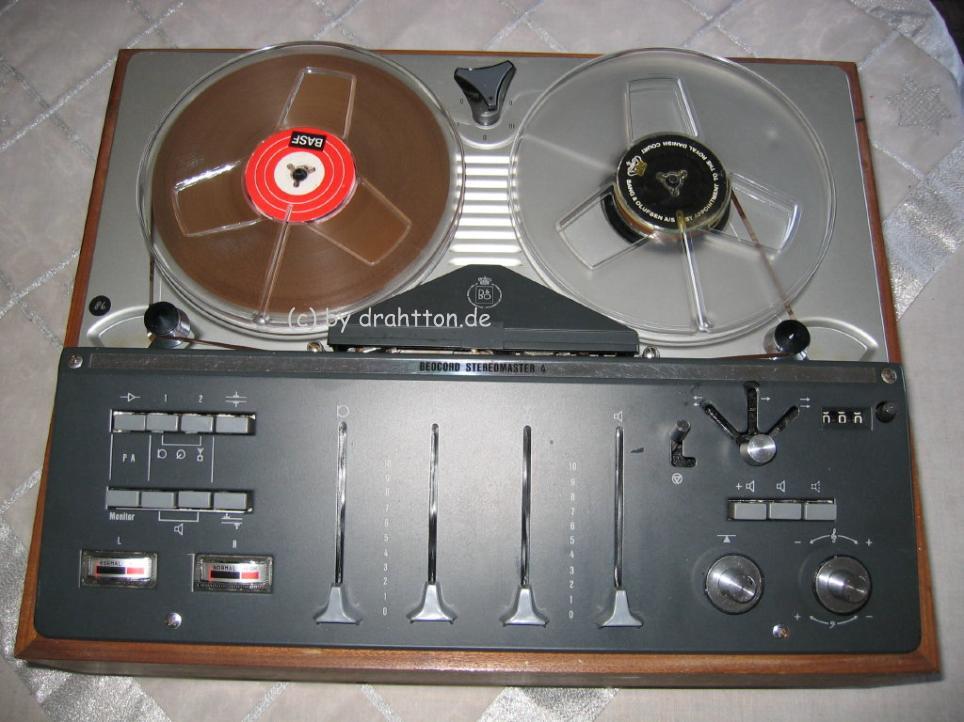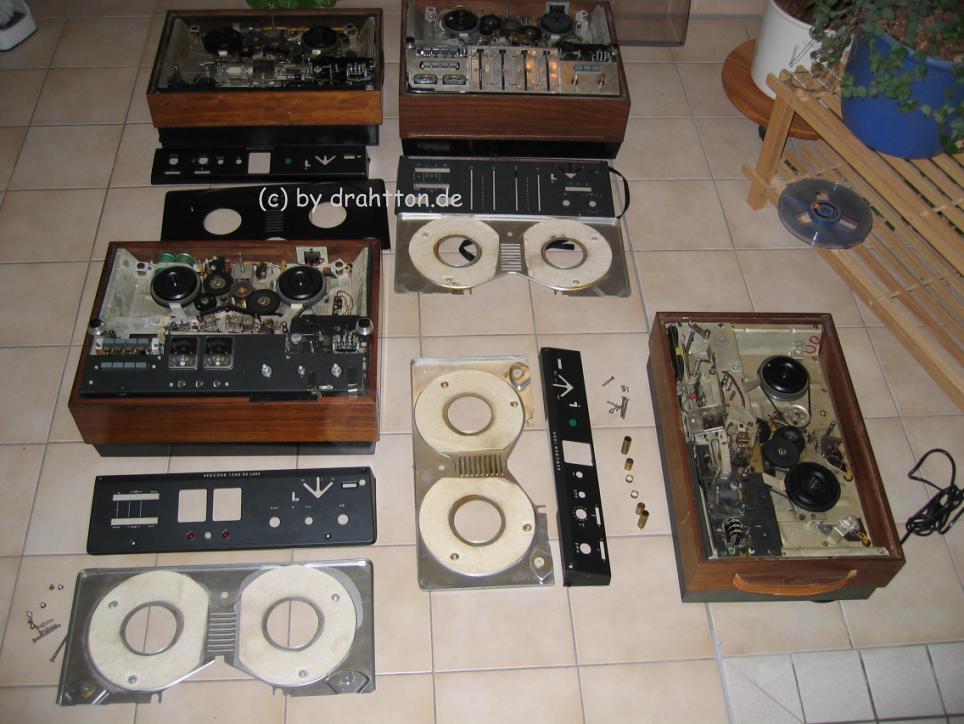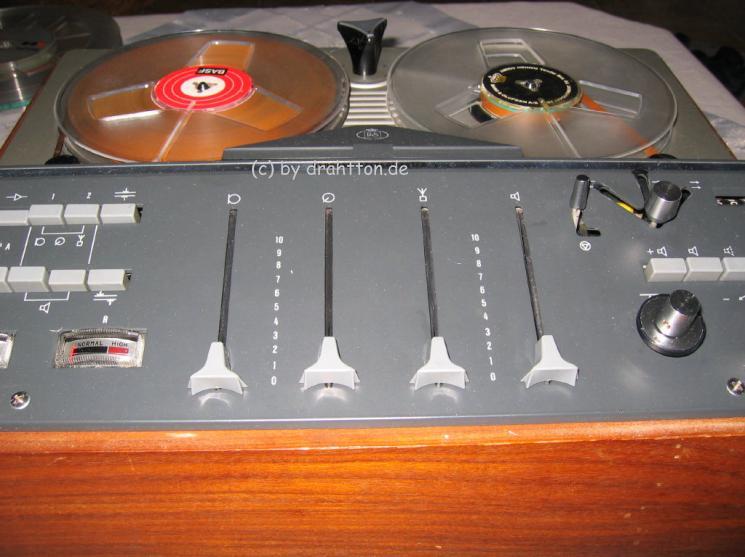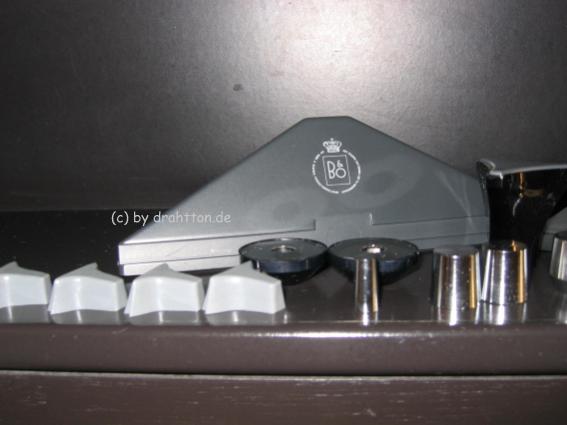
K5_3-1
www.drahtton.de
|
<- BEOCORD BELCANTO |
Übersicht |
-> BEOCORD 1000 |
BEOCORD STEREOMASTER 4
1963-1964

K5_3-1
Der
Beocord Stereomaster war ein Spulentonbandgerät, das als Novum für seine Zeit
eine Automatik-Stop-Funktion hatte,
die bei einem Bandriss die Maschine stoppte.
Es gab
dieses Gerät in zwei Versionen: Der Type T war als portables Gerät konzipiert;
während der Type K für
den stationären Betrieb ausgelegt war.

Der
B&O Beocord Stereomaster war das ideale Gerät für den engagierten
Tonbandamateur. Zum ersten Mal hatte ein Amateur
die Möglichkeit, drei Eingangssignale gleichzeitig zu mischen! Er war das erste
volltransistorierte HIFI Gerät mit
professionellen Möglichkeiten:
(1) Synchronmotor von Papst
(2) Getrennte Aufnahme- und Wiedergabeköpfe
(3) Die Aufnahme konnte sowohl gleichzeitig über den Aufnahme-Verstärker als
auch nach der Aufnahme über einen
Monitor-Verstärkerausgang kontrolliert werden.
(4) zwei getrennte VU-Meter.
(5) Drei Zweikanal-Eingänge.
(6) Professionelle Anforderungen für Geschwindigkeit und
Gleichlaufschwankungen.
Abmessungen, Type T (Transportable model)
Länge:
45 cm
Breite: 35 cm
Höhe mit Lautsprechern: 27cm
Höhe ohne Lautsprecher: 19cm
Abmessungen, Type K
Länge; 45
cm
Breite; 35,5 cm
Höhe mit Abdeckhaube: 21cm
Beocord Stereomaster 610K
(1963-?) Stereo tape recorder,
17/8, 33/4, 71/2 IPS, two or four track format, 2x6W The Beocord Stereomaster
was the first in
a long line of excellent stereo tape recorders that featured 3 heads, mixing
capabilities and all-transistor modular construction. They
offered near-professional performance for the home user, though their high
price put them out of reach for all but the wealthy few.
Throughout the series, these machines were amongst the most expensive items in
the B&O range.
For the capabilities it offered, the Beocord Stereomaster was fairly
compact. It came in a neat, wood trimmed cabinet, which was
known as the "cassette" version. This confusing title in fact meant
that the machine fitted readily into a space provided in B&O
radiograms, it is just unfortunate that the word took on other meanings later
on in the development of tape recorders. The deck was
large enough to accommodate 7" spools, which would allow 45 minutes of
high quality stereo recording if normal tape was used at
the highest speed. The four-track version doubled this figure as the tape could
be turned over, though the narrower tracks meant that
the noise performance was not quite as good. At the front of the machine there
was a control panel with push buttons and sliding faders,
an unusual fitment to domestic equipment at that time. The tape transport was
controlled by a single "joystick" lever, which was
interlocked to the record switches to prevent accidental erasure of existing
recordings.
Because the Beocord Stereomaster had separate heads and separate
amplifiers for recording and playback, it was possible to monitor
a recording "off the tape" as it was being made. In addition, there
were separate stereo preamplifiers for a microphone, a record player
and a radio tuner, the outputs of which could be mixed using the sliders and
recorded individually or in combination. Finally, a built-in
stereo power amplifier of 6W per channel (a good figure for the period) was
included for playback through external loudspeakers. This
arrangement allowed for great flexibility, and in addition to being able to
make superb stereo recordings, the machine could be used to
assemble multiple recordings onto one track and as an echo generator. A
facility to use the amplifier only, without starting the motor,
was provided, so that the Beocord Stereomaster could be used as the
centrepiece of a complete hi-fi system. The pre-amplifiers were
in the form of small plug-in cards and could be exchanged as the user desired.
The record player preamplifier was available in two versions,
one for a standard crystal pickup and one for Beogram turntables with a
magnetic pickup. This density of function in a reasonably compact
machine was made possible by the use of transistorised circuitry, it would not
have been practical to make such a machine if valves had
been used. As with all transistor recorders, moving coil meters were used to
show the correct recording level. These were illuminated in white
to show the machine was switched on, but changed to red if a recording was
being made.
Mechanically, these machines were well designed and sturdy. A single Papst
motor was used, complete with a stepped pulley for three speed
drive. The speed selector included switches for equalisation, ensuring that
recordings were made correctly to the NARTB standard, the same
as was used in European recording studios at the time. The tape path included
"slack absorbers", which effectively isolated the tape that was
in
contact with the heads from jerks and other mechanical disturbances that could
result from uneven reeling or prolonged storage. The die-cast
head cover was easily removable for cleaning and inspection of the heads.
The Beocord Stereomaster quickly gained a reputation for quality and
versatility, and become a great success. The format it established
continued
in production well into the 1970s, the next version being known as the Beocord 2000.
Beocord Stereomaster 610T
(1963-?) Stereo tape recorder,
17/8, 33/4, 71/2 IPS, two or four track format, 2x6W
This machine was technically
identical to the Beocord Stereomaster 610K, the difference was that it was supplied in a "luggage"
cabinet complete
with a latching lid and a carrying handle. The lid was divided into two halves,
each of which contained a loudspeaker. These loudspeakers were of a
special Philips design that had the magnetic assembly fitted inside the cone
rather than behind it, so tapes could safely be left in place without fear
of
recordings on them being spoiled. The cabinet was banded in polished stainless
steel to protect the delicate equipment inside.

Bei den
Stereomastern wurde zum ersten Mal relativ viel Kunststoff verwendet. Dass dieses
keine
„Billig“-Lösung war, wird deutlich, wenn man beim Reinigen des Gerätes
erkennt, dass allein der
Netz-Gechwindigkeit-Drehknauf aus mindesten vier Einzelteilen besteht und auch
noch bedruckt
ist! Mit dem „Batteriemesswerk“ als Aussteuerunganzeige mag ich mich hingegen
nicht so recht
anfreunden.
Eigentlich schon untypisch: Knöpfe, Schieberköpfe und . . .

. . . Tonkopfabdeckung waren aus Kunststoff. Dafür wurde der Benutzer mit professionel anmutenden Schiebereglern belohnt.